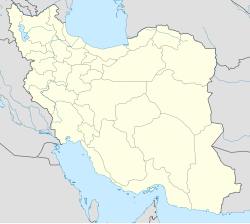Top Qs
Timeline
Chat
Perspective
Baneh
City in Kurdistan province, Iran From Wikipedia, the free encyclopedia
Remove ads
Baneh (Persian: بانه)[a] is a city in the Central District of Baneh County, Kurdistan province, Iran, serving as capital of both the county and the district.[6] Baneh is approximately 30 km (18 miles) from Kurdistan Region in Iraq.
Remove ads
History
Summarize
Perspective
Historically, Baneh had a strategic and political importance due to its close proximity to the Ottoman Empire. The city was part of the three Kurdish principalities; Ardalan, Baban and Mokryan.[7]
The old city had two citadels and was generally ruled by the Eḵtīār-al-Dīn family who held both religious and secular power of the city. The family was held in high esteem during the Safavid era and received the title 'sultan'. Moreover, rulers of Baneh had the responsibility of protecting the whole area from Khoy to Kermanshah. In the 16th century, Mīrzā Beg b. Mīr Moḥammad became the first virtually independent ruler of Baneh and its surroundings.[7]
During the 18th and 19th centuries, the city was plagued with epidemics which killed a large portion of the population. In 1944, the city experienced turmoil as part of the Hama Rashid revolt and was also bombed by both parties during the Iran–Iraq War in the 1980s. Most locals fled to Iraq during the war and much of the region was destroyed.[7]
The burning of Baneh by Iraqi Kurds
In 1905, the city of Baneh was set on fire by Hama Rashid Darukhani, the son of Ghader (Qader) Shiwegwezan (one of the Iraqi Kurdish criminals from Sulaymaniyah). During the fire, the city of Baneh was turned into a pile of ashes, and except for a few houses, the number of which did not exceed the fingers of the hand, there was no house left. In this incident, more than a thousand houses in Baneh city were set on fire by Hama Rashid Darukhani.[8]
Unfortunately for the people of Baneh, there were dozens of barrels of oil belonging to Hama Amin Bakhtari in one of his shops. The perpetrators of the crime broke the door of the store and brought oil drums and sprinkled them on the houses and set them on fire. During the fire, Hame Rashid took a position in Arbaba vineyards and watched the fire with a camera.[9]
Because the houses of that time were mostly stuck together and their roofs were completely covered with wooden beams and tree leaves, the speed of fire transmission and development was high. When a house catches fire, a neighborhood becomes a victim of fire.[10]
The arrival of cold and the fall of autumn rains made people unable to return to the city on time. Baneh soil is not very resistant to cold and rain and caused most of the walls to collapse in winter and people suffered more losses because of this.[11]
Remove ads
Climate
Remove ads
Demographics
Language and ethnicity
The population is mostly Shafiʽi Kurdish who speak Sorani.[7]
Population
At the time of the 2006 National Census, the city's population was 69,635 in 15,857 households.[15] The following census in 2011 counted 85,190 people in 22,149 households.[16] The 2016 census measured the population of the city as 110,218 people in 30,743 households.[2] After the cities of Sanandaj, Saqqez and Marivan, Baneh is the fourth most populous city in Kurdistan province.[citation needed]
Notable people
- Ebrahim Younesi, writer and translator
- Bahman Ghobadi, director and writer
- Ata Nahaei, novelist and translator
- Ebrahim Alipour, photographer
- Keywan Karimi, director
Gallery
- View of the city from Dokanan Park
- View of Arbaba on a winter's day
- Baneh by day
- Shahr Park in spring
- Haleh International 5-Star hotel
- Behesht Shopping Center
- Aftab Derakhshan shopping center
- Sooren plain and forest
- Arbaba forest
- Snow covered Kali Khan
![]() Media related to Baneh at Wikimedia Commons
Media related to Baneh at Wikimedia Commons
Notes
References
Wikiwand - on
Seamless Wikipedia browsing. On steroids.
Remove ads












